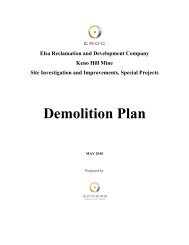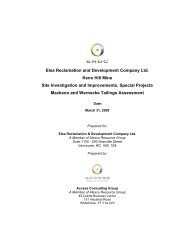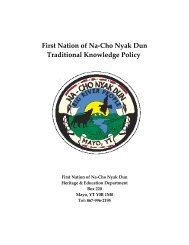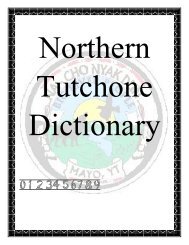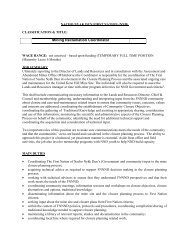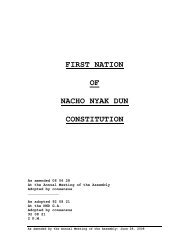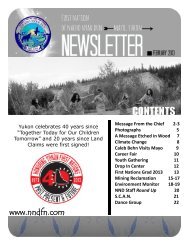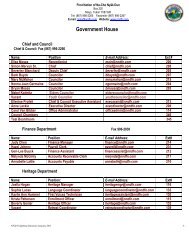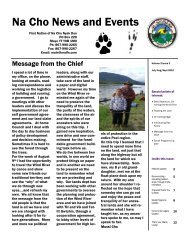- Page 2 and 3: FINAL HUMAN HEALTH AND ECOLOGICAL R
- Page 4 and 5: Human Health and Ecological Risk As
- Page 8 and 9: Human Health and Ecological Risk As
- Page 10 and 11: Human Health and Ecological Risk As
- Page 12 and 13: Human Health and Ecological Risk As
- Page 14 and 15: Human Health and Ecological Risk As
- Page 16 and 17: Human Health and Ecological Risk As
- Page 18 and 19: Human Health and Ecological Risk As
- Page 20 and 21: Human Health and Ecological Risk As
- Page 22 and 23: Human Health and Ecological Risk As
- Page 24 and 25: Human Health and Ecological Risk As
- Page 26 and 27: Human Health and Ecological Risk As
- Page 28 and 29: Human Health and Ecological Risk As
- Page 30 and 31: Human Health and Ecological Risk As
- Page 32 and 33: Human Health and Ecological Risk As
- Page 34 and 35: Notes: Map adapted from Minnow 2010
- Page 36 and 37: Human Health and Ecological Risk As
- Page 38 and 39: Constituent Human Health and Ecolog
- Page 40 and 41: Human Health and Ecological Risk As
- Page 42 and 43: Human Health and Ecological Risk As
- Page 44 and 45: Human Health and Ecological Risk As
- Page 46 and 47: Constituent Human Health and Ecolog
- Page 48 and 49: Parameter Human Health and Ecologic
- Page 50 and 51: Human Health and Ecological Risk As
- Page 52 and 53: Human Health and Ecological Risk As
- Page 54 and 55: Human Health and Ecological Risk As
- Page 56 and 57:
Human Health and Ecological Risk As
- Page 58 and 59:
Human Health and Ecological Risk As
- Page 60 and 61:
Human Health and Ecological Risk As
- Page 62 and 63:
Human Health and Ecological Risk As
- Page 64 and 65:
Human Health and Ecological Risk As
- Page 66 and 67:
Bear Beaver Caribou Human Health an
- Page 68 and 69:
Human Health and Ecological Risk As
- Page 70 and 71:
Human Health and Ecological Risk As
- Page 72 and 73:
Human Health and Ecological Risk As
- Page 74 and 75:
Human Health and Ecological Risk As
- Page 76 and 77:
Human Health and Ecological Risk As
- Page 78 and 79:
Human Health and Ecological Risk As
- Page 80 and 81:
Notes: locations are approximate Hu
- Page 82 and 83:
Human Health and Ecological Risk As
- Page 84 and 85:
COPC LC Human Health and Ecological
- Page 86 and 87:
Human Health and Ecological Risk As
- Page 88 and 89:
Receptor Area Hare GH MT VT Human H
- Page 90 and 91:
Human Health and Ecological Risk As
- Page 92 and 93:
Human Health and Ecological Risk As
- Page 94 and 95:
Human Health and Ecological Risk As
- Page 96 and 97:
Human Health and Ecological Risk As
- Page 98 and 99:
Human Health and Ecological Risk As
- Page 100 and 101:
Human Health and Ecological Risk As
- Page 102 and 103:
Human Health and Ecological Risk As
- Page 104 and 105:
Human Health and Ecological Risk As
- Page 106 and 107:
Human Health and Ecological Risk As
- Page 108 and 109:
Human Health and Ecological Risk As
- Page 110 and 111:
Human Health and Ecological Risk As
- Page 112 and 113:
Human Health and Ecological Risk As
- Page 114 and 115:
COPC Human Health and Ecological Ri
- Page 116 and 117:
COPC Human Health and Ecological Ri
- Page 118 and 119:
Human Health and Ecological Risk As
- Page 120 and 121:
Human Health and Ecological Risk As
- Page 122 and 123:
Human Health and Ecological Risk As
- Page 124 and 125:
Human Health and Ecological Risk As
- Page 126 and 127:
Human Health and Ecological Risk As
- Page 128 and 129:
Human Health and Ecological Risk As
- Page 130 and 131:
Human Health and Ecological Risk As
- Page 132 and 133:
Human Health and Ecological Risk As
- Page 134 and 135:
Human Health and Ecological Risk As
- Page 136 and 137:
Human Health and Ecological Risk As
- Page 138 and 139:
Human Health and Ecological Risk As
- Page 140 and 141:
Human Health and Ecological Risk As
- Page 142 and 143:
Human Health and Ecological Risk As
- Page 144 and 145:
Cobalt Human Health and Ecological
- Page 146 and 147:
Human Health and Ecological Risk As
- Page 148 and 149:
Nickel Human Health and Ecological
- Page 150 and 151:
Human Health and Ecological Risk As
- Page 152 and 153:
Human Health and Ecological Risk As
- Page 154 and 155:
COPC Human Health and Ecological Ri
- Page 156 and 157:
Human Health and Ecological Risk As
- Page 158 and 159:
Human Health and Ecological Risk As
- Page 160 and 161:
COPC and Aquatic Receptor Human Hea
- Page 162 and 163:
COPC and Aquatic Receptor Human Hea
- Page 164 and 165:
Human Health and Ecological Risk As
- Page 166 and 167:
Human Health and Ecological Risk As
- Page 168 and 169:
Human Health and Ecological Risk As
- Page 170 and 171:
Human Health and Ecological Risk As
- Page 172 and 173:
Human Health and Ecological Risk As
- Page 174 and 175:
Human Health and Ecological Risk As
- Page 176 and 177:
Human Health and Ecological Risk As
- Page 178 and 179:
Human Health and Ecological Risk As
- Page 180 and 181:
Human Health and Ecological Risk As
- Page 182 and 183:
Human Health and Ecological Risk As
- Page 184 and 185:
Human Health and Ecological Risk As
- Page 186 and 187:
Human Health and Ecological Risk As
- Page 188 and 189:
Human Health and Ecological Risk As
- Page 190 and 191:
Human Health and Ecological Risk As
- Page 192 and 193:
Human Health and Ecological Risk As
- Page 194 and 195:
Human Health and Ecological Risk As
- Page 196 and 197:
Human Health and Ecological Risk As
- Page 198 and 199:
Human Health and Ecological Risk As
- Page 200 and 201:
Human Health and Ecological Risk As
- Page 202 and 203:
Human Health and Ecological Risk As
- Page 204 and 205:
Human Health and Ecological Risk As
- Page 206 and 207:
Human Health and Ecological Risk As
- Page 208 and 209:
Human Health and Ecological Risk As
- Page 210 and 211:
Human Health and Ecological Risk As
- Page 212 and 213:
Human Health and Ecological Risk As
- Page 214 and 215:
Human Health and Ecological Risk As
- Page 216 and 217:
Human Health and Ecological Risk As
- Page 218 and 219:
Human Health and Ecological Risk As
- Page 220 and 221:
Human Health and Ecological Risk As
- Page 222 and 223:
Human Health and Ecological Risk As
- Page 224 and 225:
Human Health and Ecological Risk As
- Page 226 and 227:
Human Health and Ecological Risk As
- Page 228 and 229:
Human Health and Ecological Risk As
- Page 230 and 231:
B.1 HUMAN RECEPTOR RESULTS Human He
- Page 232 and 233:
Human Health and Ecological Risk As
- Page 234 and 235:
Human Health and Ecological Risk As
- Page 236 and 237:
Human Health and Ecological Risk As
- Page 238 and 239:
COPC Human Health and Ecological Ri
- Page 240 and 241:
COPC Human Health and Ecological Ri
- Page 242 and 243:
COPC Human Health and Ecological Ri
- Page 244 and 245:
COPC Human Health and Ecological Ri
- Page 246 and 247:
COPC Human Health and Ecological Ri
- Page 248 and 249:
COPC Human Health and Ecological Ri
- Page 250 and 251:
COPC Human Health and Ecological Ri
- Page 252 and 253:
Human Health and Ecological Risk As
- Page 254 and 255:
B.2 ECOLOGICAL RECEPTOR RESULTS Hum
- Page 256 and 257:
Human Health and Ecological Risk As
- Page 258 and 259:
Human Health and Ecological Risk As
- Page 260 and 261:
Human Health and Ecological Risk As
- Page 262 and 263:
Human Health and Ecological Risk As
- Page 264 and 265:
Human Health and Ecological Risk As
- Page 266 and 267:
Human Health and Ecological Risk As
- Page 268 and 269:
Human Health and Ecological Risk As
- Page 270 and 271:
Human Health and Ecological Risk As
- Page 272 and 273:
Human Health and Ecological Risk As
- Page 274 and 275:
Human Health and Ecological Risk As
- Page 276 and 277:
Human Health and Ecological Risk As
- Page 278 and 279:
Human Health and Ecological Risk As
- Page 280 and 281:
Human Health and Ecological Risk As
- Page 282 and 283:
Human Health and Ecological Risk As
- Page 284 and 285:
Human Health and Ecological Risk As
- Page 286 and 287:
Human Health and Ecological Risk As
- Page 288 and 289:
Human Health and Ecological Risk As
- Page 290 and 291:
Human Health and Ecological Risk As
- Page 292 and 293:
Human Health and Ecological Risk As
- Page 294 and 295:
Human Health and Ecological Risk As
- Page 296 and 297:
Human Health and Ecological Risk As
- Page 298 and 299:
Human Health and Ecological Risk As
- Page 300 and 301:
Human Health and Ecological Risk As
- Page 302 and 303:
Human Health and Ecological Risk As
- Page 304 and 305:
Human Health and Ecological Risk As
- Page 306 and 307:
Human Health and Ecological Risk As
- Page 308 and 309:
Human Health and Ecological Risk As
- Page 310 and 311:
Human Health and Ecological Risk As
- Page 312 and 313:
D.2 HUMAN RECEPTORS Human Health an
- Page 314 and 315:
Human Health and Ecological Risk As



